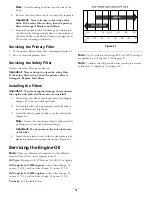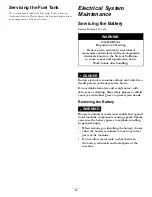
Transporting Machines
Use a heavy-duty trailer or truck to transport the machine.
Ensure that the trailer or truck has all necessary brakes,
lighting, and marking as required by law. Please carefully read
all the safety instructions. Knowing this information could
help you, your family, pets or bystanders avoid injury.
WARNING
Driving on the street or roadway without turn
signals, lights, reflective markings, or a slow
moving vehicle emblem is dangerous and can lead
to accidents causing personal injury.
Do not drive machine on a public street or roadway.
To transport the machine:
1.
If using a trailer, connect it to the towing vehicle and
connect the safety chains.
2.
If applicable, connect the trailer brakes.
3.
Load the machine onto the trailer or truck.
4.
Stop the engine, remove the key, set the brake, and
close the fuel valve.
5.
Use the metal tie down loops on the machine to
securely fasten the machine to the trailer or truck with
straps, chains, cable, or ropes (Figure 39).
Figure 39
1.
Traction unit tie down loops
Loading Machines
Use extreme caution when loading units on trailers or trucks.
One full width ramp that is wide enough to extend beyond
the rear tires is recommended instead of individual ramps for
each side of the unit (Figure 40). The lower rear section of
the machine frame extends back between the rear wheels and
serves as a stop for tipping backward. Having a full width
ramp provides a surface for the frame members to contact if
the unit starts to tip backward. If it is not possible to use one
full width ramp, use enough individual ramps to simulate a
full width continuous ramp.
The ramp should be long enough so that the angles do not
exceed 15 degrees (Figure 40). A steeper angle may cause
mower components to get caught as the unit moves from
ramp to trailer or truck. Steeper angles may also cause the
unit to tip backward. If loading on or near a slope, position
the trailer or truck so it is on the down side of the slope and
the ramp extends up the slope. This will minimize the ramp
angle. The trailer or truck should be as level as possible.
Important:
Do Not attempt to turn the unit while on
the ramp; you may lose control and drive off the side.
Avoid sudden acceleration when driving up a ramp and
sudden deceleration when backing down a ramp. Both
maneuvers can cause the unit to tip backward.
WARNING
Loading a unit onto a trailer or truck increases the
possibility of backward tip-over and could cause
serious injury or death.
•
Use extreme caution when operating a unit on
a ramp.
•
Ensure the ROPS is in the up position while
using the seat belt when loading the machine.
Ensure the ROPS will clear the top of an
enclosed trailer.
•
Use only a single, full width ramp; Do Not use
individual ramps for each side of the unit.
•
If individual ramps must be used, use enough
ramps to create an unbroken ramp surface wider
than the unit.
•
Do not exceed a 15 degree angle between ramp
and ground or between ramp and trailer or truck.
•
Avoid sudden acceleration while driving unit up
a ramp to avoid tipping backward.
•
Avoid sudden deceleration while backing unit
down a ramp to avoid tipping backward.
27
Summary of Contents for 74901 Z Master 5000
Page 66: ...Schematics Wire Diagram Rev A 66 ...
Page 67: ...Notes 67 ...
















































